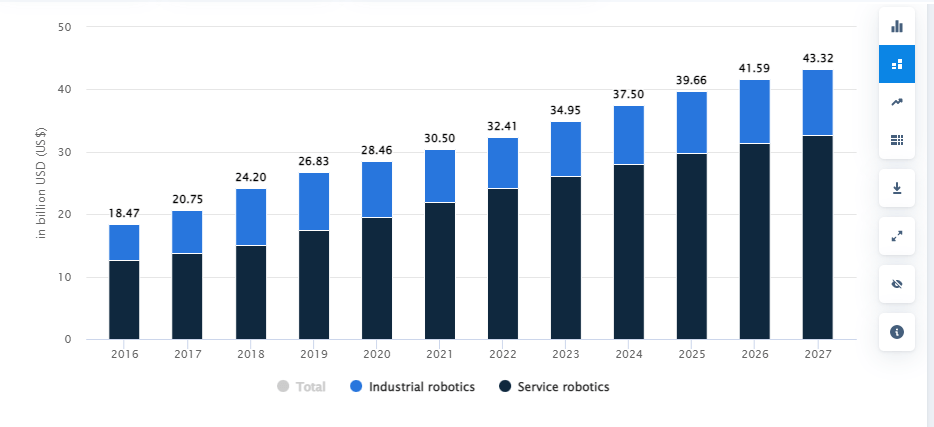
Moonpreneur
Robotics is a rapidly growing field that has fascinated people of all ages across the World, but it can be particularly intriguing for children and young adults. The world of robotics offers endless possibilities for exploration and creativity, and it can be a fun and educational way to spark an interest in science, engineering, and technology.
In this blog, we’ve compiled a list of 20 frequently asked questions about robotics and provided concise answers to help 8-15-year-olds better understand this fascinating field.

Source: Statista
Revenue in the Robotics market is projected to reach US$34.94bn in 2023.
1) What is Robotics?
Robotics is the branch of engineering that deals with the design, construction, operation, and use of robots. Robots are machines capable of performing tasks without human intervention, and we can program them to perform various functions.
2) What is the history of Robotics?
The idea of robots dates back to ancient times when myths and legends featured mechanical beings. We developed the first robots in modern history in the early 20th century and have been rapidly advancing ever since. Today, robots play a crucial role in many industries, such as manufacturing, healthcare, entertainment, and military applications.
3) How do robots work?
Robots typically consist of three main components: a power source, a control system, and a mechanical system. The power source provides energy to the robot, the control system directs its movements and operations, and the mechanical system gives the robot its physical form and capabilities. Robots also often have sensors that allow them to detect and respond to changes in their environment.
4) What are some common types of robots?
There are many types of robots, but some of the most common include industrial robots, service robots, and domestic robots. Industrial robots are used in manufacturing, and other industrial processes, service robots perform tasks for people, and domestic robots are used in homes and other domestic settings.
5) What is AI in robotics?
AI, or artificial intelligence, refers to the ability of robots to perform tasks that normally require human intelligence. This includes tasks such as recognizing patterns, decision-making and learning from experience. AI is a rapidly growing field, and it has the potential to revolutionize how robots are used in the future.
6) Can robots replace human workers?
In some cases, robots can replace human workers, but in others, they complement and augment human workers. It depends on the specific task and the level of automation technology.
7) How do robots make decisions?
Robots make decisions based on the data they receive from their sensors and the algorithms programmed into their control system. If concrete actions are not planned, the robot could use mathematical optimization methods to decide how to act. Mathematical optimization is a technique for achieving the best possible result under given circumstances, called constraints.
8) What is the difference between an autonomous and a non-autonomous robot?
An autonomous robot can perform tasks on its own without human intervention – it can move on its own, and it can make decisions based on sensor input. While non-autonomous robots require some sort of guidance system or instruction to make a movement that allows them to travel pre-defined navigation maps in a controlled environment.
9) What is a robot sensor?
A robot sensor is a device used to detect and respond to changes in the robot’s environment. Sensors can detect things like light, temperature, sound, and movement, and they play an important role in helping robots navigate and interact with their environment.
10) What is the purpose of actuators in robots?
Actuators are responsible for moving the robot’s parts, which is often achieved using motors based on the commands from its control system. For example, An actuator is needed to make the robot’s wheels turn. Or the joints of a robot arm to rotate.
11) What is robot software?
Robot software is the code used to control a robot’s movements and operations. The software can program the robot to perform specific tasks, which is a critical component of most robots.
12) What is a robot operating system?
A robot operating system (ROS) is a type of software that is designed specifically for use with robots. ROS provides tools and libraries that can program robots and control their movements and operations.
13) What is a robot simulator?
A robot simulator is a software program that allows you to test and experiment with robots in a virtual environment. Robot simulators can test the behavior and performance of robots with no expensive hardware, and they are valuable tools for developers and researchers.
14) What is the language of robots?
A robot language is a type of programming language that is used to control and program robots. There are many types of robot languages, and they are used to write the code that is used to program the robots and control their movements and operations.
15) What is machine learning in robotics?
Machine learning is a condition where the robots are programmed in such a way that with timely evolution, they learn from their own mistakes, thus preventing constant human intervention and parallel effort.
16) What are some ethical considerations for using robots?
Ethical considerations when using robots include issues related to privacy, safety, job displacement, and the responsible use of technology. The uses of technology have the capability of making many innocent people suffer, and this is a moral concern. An example of such an issue can be the fact that nuclear technology has the potential to kill many people and consequently destroy the environment.
17) What are some advantages of using robots in the industry?
The advantages of using robots in the industry include increased efficiency, consistency, precision, and safety, reduced costs and increased output. Unlike humans, robots don’t get bored. Until they wear out, they can do the same thing again and again.
18) What is a robot framework?
A robot framework is a set of tools and libraries used to develop and test robots. The framework provides a standardized way to program and controls robots, and it can build a wide range of different robots.
19) What is the future of Robotics?
The future of robotics is uncertain, but robots will continue to play an increasingly important role in our lives. In the coming years, robots are likely to become more advanced and capable, and they will likely be used in a growing number of industries and applications. As technology continues to evolve, the possibilities for robotics are endless, and we can expect to see many exciting developments in this field in the years to come.
20) What are some common applications of robotics?
Robots are used in a wide variety of jobs such as materials handling, painting, picking, packing and palletizing, mechanical cutting, grinding, assembling automobiles, harvesting crops, and delivering medications.
They can also perform tasks that are dangerous, repetitive, or too complex for humans to perform, and they are also being developed for use in space exploration and other cutting-edge fields.
Robotics has the potential to revolutionize the way we live and work. With the advancement of technology, robots are becoming more capable of performing complex tasks and operating in a wider range of environments. As we continue to explore the possibilities of robotics, it is important to consider the ethical and social implications of this technology.
Despite its limitations, the potential benefits of robotics are immense and hold great promise for improving our lives and solving some of the world’s biggest challenges.
We hope that this list of 20 frequently asked questions about robotics has helped to shed some light on this exciting field and has sparked an interest in robotics for 8-15-year-olds.
Moonpreneur understands the needs and demands this rapidly changing technological world is bringing with it for our kids and thus we are on a mission to educate and ignite the flames of entrepreneurship through our holistically created online STEM programs which will help kids master the futuristic sciences such as Robotics, Game Development, App Development, Advanced Math and much more!!
Register for a free 60-minute Robotics class today!

















What will robots do in 10 years?
AI may automate approximately 39% of domestic work within a decade, according to a study involving 65 AI experts from the UK and Japan. The researchers sought predictions on the potential for automation to alleviate common household and caregiving tasks.
Who is the first robot?
George Devol invented the first digitally operated and programmable robot in 1954, known as the Unimate. This groundbreaking invention became the cornerstone of the modern robotics industry.